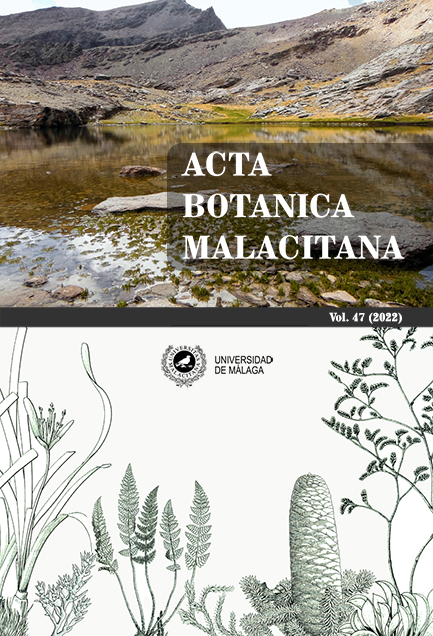Lobularia libyca (Viv.) Meisn. (Brassicaceae), una nueva especie para la flora continental portuguesa
DOI:
https://doi.org/10.24310/abm.v47i.15084Palabras clave:
Brassicaceae, Portugal continental, Lobularia libycaResumen
La Brassicacea anual Lobularia libyca se describe por primera vez en Portugal continental. Una sola población aislada, compuesta por plantas bien fructificadas que se acercaban al final de su ciclo de vida, se encontró en Ria Formosa (Algarve, sur de Portugal) en 2022, y se estimó en menos de 120 individuos reproductivos. Se discute el estado nativo y la aparente rareza de la especie, o al menos de registros, en la región.
Descargas
Métricas
Citas
Carapeto A., Francisco A., Pereira P., Porto M. (eds.) (2020). Lista Vermelha da Flora Vascular de Portugal Continental. Sociedade Portuguesa de Botânica, Associação Portuguesa de Ciência da Vegetação – PHYTOS e Instituto da Conservação da Natureza e das Florestas (coord.). Coleção «Botânica em Português», Volume 7. Lisboa: Imprensa Nacional.
Coutinho, A. (1939). Flora de Portugal (Plantas Vasculares) 2ª Ed. Lisboa: Bertran.
Cueto, M., Luque M. M., Giménez, E., Fuentes, J., Carrique, E. L. & Blanca, G. (2018). First updated checklist of the vascular flora of Andalusia (S of Spain), one of the main biodiversity centres in the Mediterranean Basin. Phytotaxa, 339, 1–95.
Fernandes, RB (1997). Lobularia Desv. [nom. cons.]. In Castroviejo, S. et al. (Eds). Flora iberica 4 (pp. 196-200). Madrid: Real Jardín Botánico, C.S.I.C.
GBIF.org (2022). Lobularia libyca (Viv.) Meisn. In GBIF Secretariat (2021). GBIF Backbone Taxonomy. Checklist dataset https://www.gbif.org/species/5373339 accessed via GBIF.org on 2022-04-05.
Grupo Botânico da Madeira (2013). Checklist da Flora do Arquipélago da Madeira, accessed via http://www4.uma.pt/gbm/checklist/lista_flora.php) on 2022-04-05.
Franco, J. (1971). Nova Flora de Portugal (Continente e Açores). Lisboa: Autor.
Hernández-Bermejo, J.E. & Hidalgo, B. (1987). 18. Lobularia Desv., Jorn. Bot. Agric. 3: 162 (1815), nom cons. In Valdés et al. (Eds) Flora Vascular de Andalucía Occidental 1 (pp. 400-401). Barcelona: Ketres.
Holyoak D. (2008). Lobularia maritima (L.) Desv. subsp. maritima - mapa de distribuição. In F.Clamote, A.Carapeto, P.Beja, M.Porto, P.V.Araújo, J.D.Almeida, M.J.Correia, U.Schwarzer, et al. (2022). Flora-On: Flora de Portugal Interactiva, Sociedade Portuguesa de Botânica. http://www.flora-on.pt/#wLobularia+maritima+subsp.+maritima, assessed 06-02-2022.
López-Albacete, I., de las Heras, M. A., Gullón, E. S., Hidalgo, P. J., Muñoz Rodríguez, A. F. (2007). 132. Aportaciones florísticas para Doñana. Lagascalia, 27, 390-402.
Quinto-Canas, R., Cano-Ortiz, A., Raposo, M., Musarella, C.M., Del Río, S., Raposo, M., Carapeto, A., Menezes, R., Piñar Fuentes, J., Bioret, F. & Pinto-Gomes, C. (2021). Coastal dune vegetation of the Ria Formosa (Algarve, Portugal) barrier island system. International Journal of Geobotanical Research, 10, 37-44.
Sequeira, M., Espírito-Santo, D., Aguiar, C., Capelo, C., & Honrado, J.J. (Eds.) (2011). Checklist da Flora de Portugal Continental, Açores e Madeira. ALFA –Associação Lusitana de Fitossociologia.
Descargas
Publicado
Cómo citar
Número
Sección
Licencia
Toda la información relacionada con la licencia de uso de los trabajos publicados en Acta Botanica Malacitana y con los derechos de autor se pueden consultar en nuestra Política Editorial.







1.png)


